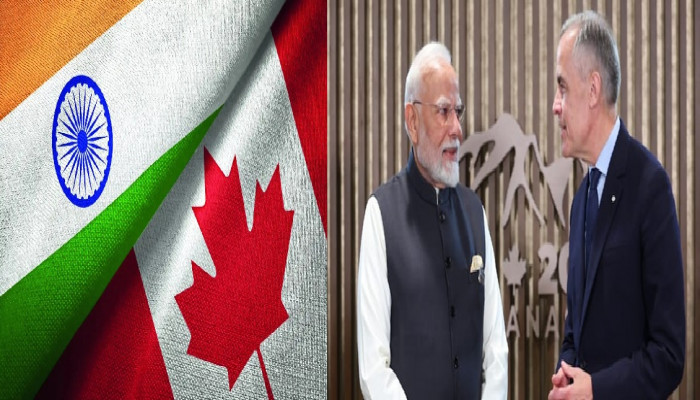Trump 2.0 Regime & India–Canada Diplomatic Reset and Rapprochement
- In Foreign Policy
- 10:03 AM, Aug 05, 2025
- Khushi Mishra & Dr. A. Adityanjee
In diplomacy, silence is often louder than war, and in 2025, the India–Canada relationship echoes with both. Not long ago, they spoke the language of trade and trust. Today, they speak cautiously if at all.
For decades, these two nations shared a relationship rooted in democratic values and people-to-people connections. Trade grew steadily, Indian students flocked to Canadian universities, and the Indian diaspora became a significant political and cultural force in Canada. But diplomacy, like all human affairs, is fragile. In September 2023, this fragility led to a full-blown diplomatic crisis.
What was once a polite partnership turned into a cold stalemate after former Canadian Prime Minister Justin Trudeau, in September 2023, on the floor of Canadian parliament, accused India of involvement in the killing of Hardeep Singh Nijjar. Trudeau failed to share any concrete evidence except for stating repeatedly that he had credible allegations based on intelligence ostensibly from the “Five Eyes” Anglo-Saxon intelligence sharing alliance.
Hardeep Singh Nijjar was a naturalised Canadian citizen and a fugitive from Indian law who initially forged his documents to enter Canada. He was spearheading a separatist movement in the Punjab province of India and was involved in illegal drug trade, gang activities, extortion and gun running. India responded swiftly, denouncing Trudeau's absurd claim and suspending visa services for Canadian nationals. Diplomats were expelled by both countries. Trust was broken.
The fallout was not just diplomatic but deeply political, ideological, and emotional. Trudeau ended up finally losing his job in disgrace without being able to provide a single shred of evidence for almost two years, except for repeating his allegations ad nauseam.
In the national elections that were called early by the new Prime Minister Mark Carney, the sure-to-win conservative party lost the elections and the Liberal party emerged as the largest party, albeit with reduced seats in the 45th Parliament and was able to form government.
Now, by mid-2025, signs of a thaw are cautiously emerging. Behind closed doors, away from the headlines and camera flashes, a slow, cautious, and calculated rapprochement may have been underway. This isn't the kind of dramatic reconciliation where leaders shake hands and flags wave in celebration. It is more complex, strategic, and revealing of the imperatives that push nations to recalibrate, even when wounds remain open.
Mark Carney, forced by circumstances, invited Prime Minister Modi for the G-7 summit that Canada hosted recently, ostensibly under pressure from other G-7 members.
The Breaking Point
To understand the reset, one must revisit the rupture. Trudeau's claim in Canada's Parliament did not emerge in a vacuum. India has long expressed concern about Sikh extremism flourishing in Canada under the banner of free speech.
For India, figures like Nijjar were not just dissidents but criminal threats to India’s national integrity. For Canada, the lines between advocacy and extremism remained blurred under the constitutional protection of expression. Trudeau was also responding to his need for political survival by indulging in vote-bank politics and mollycoddling the NDP leader Jagmeet Singh for support to his minority government.
However, Trudeau's statement shifted from internal concern to global spectacle. He internationalised a bilateral tension and pushed India into a corner. India's sharp reaction, like halting visas, downgrading diplomatic relations, and issuing strong advisories, was a message that accusations come with consequences.
For months, communication dwindled, and trust evaporated. Both nations stared each other down in silence. Ironically, chest thumping about Five Eyes intelligence ultimately did not lead to any prosecution, and Canada was itself threatened with expulsion from the Five Eyes alliance.
Shift in Strategy
In international diplomacy, isolation is rarely sustainable, especially between countries with deep economic, educational, and diaspora linkages. Both New Delhi and Ottawa began to feel the chill of a prolonged freeze.
For Canada, the economic stakes were high. Indian students form the largest group of international enrollees in Canadian institutions. They bring not just diversity, but billions of Canadian dollars in revenue. An extended diplomatic spat threatened both university enrollments and immigration inflows. Moreover, with its Indo-Pacific strategy relying heavily on relationships with democratic powers in the region, alienating India, a rising economic power and a key Quad member, was strategically short-sighted.
India, on the other hand, had little to gain from pushing Canada entirely out of its foreign policy matrix. While India could afford a public standoff, it recognised the value of maintaining communication channels. Canada is rich in resources India needs, such as energy, pulses, and minerals. The Indian diaspora in Canada is significant, influential, and politically active. Alienating them carried domestic risks.
What followed was a soft pivot. Canadian ministers, while not retracting Trudeau's claim, began to tone down their language. Indian officials, while firm on national security, stopped amplifying the issue in public forums. Multilateral spaces like the G20 became stages for silent diplomacy. No dramatic gestures were made, but neither side escalated further. The change in Canada's leadership in early 2025, with Mark Carney replacing Trudeau as Prime Minister, also injected a more measured tone into the bilateral discourse.
The Role of Diaspora and Economy
One of the strongest ties pulling the two countries back together is the Indian diaspora in Canada. With over 1.4 million people of Indian origin, the diaspora forms a crucial voter base and cultural bridge. Many are students, entrepreneurs, and professionals deeply invested in both countries. Though often muted in diplomatic matters, their voices carry weight in domestic politics, especially in Canada.
Trade too offers a path back. Prior to the diplomatic fallout, the two nations were negotiating the Early Progress Trade Agreement (EPTA), a deal expected to boost economic cooperation in sectors like technology, agriculture, and renewable energy. While talks were paused, recent signals suggest both sides are quietly exploring ways to revive negotiations. Merchandise trade remained surprisingly resilient through 2024 and early 2025, with Canadian pension funds continuing to invest in Indian infrastructure and green energy. When politics stalls, economics often nudges nations forward.
Why This Rapprochement Is Different
This isn't the first time India and Canada have faced problems. In the 1980s and 1990s, tensions simmered over the Sikh-Canadian terrorist activities and nuclear diplomacy. However, the current rupture carried a different intensity as it was televised, deeply personal, and occurred mainly at a time when global alliances were rapidly shifting.
The emerging détente isn't based on apologies or reconciliation but is grounded in realism. It shows a shared understanding that bilateral relationships, especially between democracies, cannot be defined solely by episodes of conflict. They are shaped by long-term interests, mutual dependencies, and the recognition that even cold, calculated dialogue is better than disengagement.
Indeed, a Canadian foreign interference commission report in January 2025 found no conclusive foreign role in Nijjar's killing, though later CSIS findings reignited concerns. Still, both sides are proceeding with cautious pragmatism.
Navigating the Future
The road to recovery is narrow and full of uncertainty. The Nijjar issue hasn't disappeared. Indian concerns over safe haven granted to Sikh-Canadian terrorists & extremists in Canada remain strong. Canadian insistence on human rights and democratic norms won't fade. Both countries will continue to disagree on key ideological fronts.
But diplomacy isn't about agreement. It is about managing disagreement.
In the coming months, we may not see any grand announcements. There may be no joint statements or media-friendly photo-ops. However, we may likely witness the slow rebuilding of functional ties, resumption of trade dialogues, a quiet restoration of educational cooperation, and reopening of visa channels.
High commissioner appointments are reportedly being considered, and limited sectoral talks have resumed behind the scenes. More importantly, both countries have chosen conversation over confrontation. In an increasingly polarised world, that choice alone signals maturity.
However, a lot has also changed in the international arena since then. There is a new jingoistic administration in Washington, DC, that has created international chaos and triggered a trade war. Both Canada and India, which had friendly relations with the US, are now targets of Trumpian irrational fury and subject to never-ending unilateral tariffs.
Canada has lost a major market closer to home, and the proposed tariffs are likely to shrink the Canadian economy. Furthermore, Trump is determined to continue lusting for Canadian territory and natural resources and has never shied away from his idea of swallowing Canada as the 51st state of the US.
On the other hand, the threat of tariffs may not affect a more resilient Indian economy as it relies more on domestic consumption for its GDP growth compared to exports. Canada has an excellent opportunity to mend bilateral relations with India, a huge market for the export of Canadian energy, hydrocarbons and other natural resources. An energy-starved India will buy hydrocarbons and energy from any exporter country if market forces and discounted prices are to India’s advantage.
Conclusion
India and Canada are both democracies, but their politics and priorities differ. However, what binds them is the recognition that isolation is not a strength in an interconnected world, but silence is. And silence, while useful in moments of anger, cannot be the foundation of foreign policy.
If it continues, this diplomatic reset will not be born from friendship but prudence under the looming threat of tariffs from a third party. This marks not reconciliation, but a carefully calculated rapprochement for economic survival. And that, perhaps, is more durable. Canada needs Indian markets, Indian tourists, and Indian students to sustain its economy that is likely to go into recession under Trumpian tariffs.
In geopolitics, the strongest bridges are not built in moments of peace, but in the ruins of misunderstanding. The ball is in Canada’s court for geo-political realism.
Disclaimer: The opinions expressed within this article are the personal opinions of the author. MyIndMakers is not responsible for the accuracy, completeness, suitability, or validity of any information on this article. All information is provided on an as-is basis. The information, facts or opinions appearing in the article do not reflect the views of MyindMakers and it does not assume any responsibility or liability for the same.







Comments